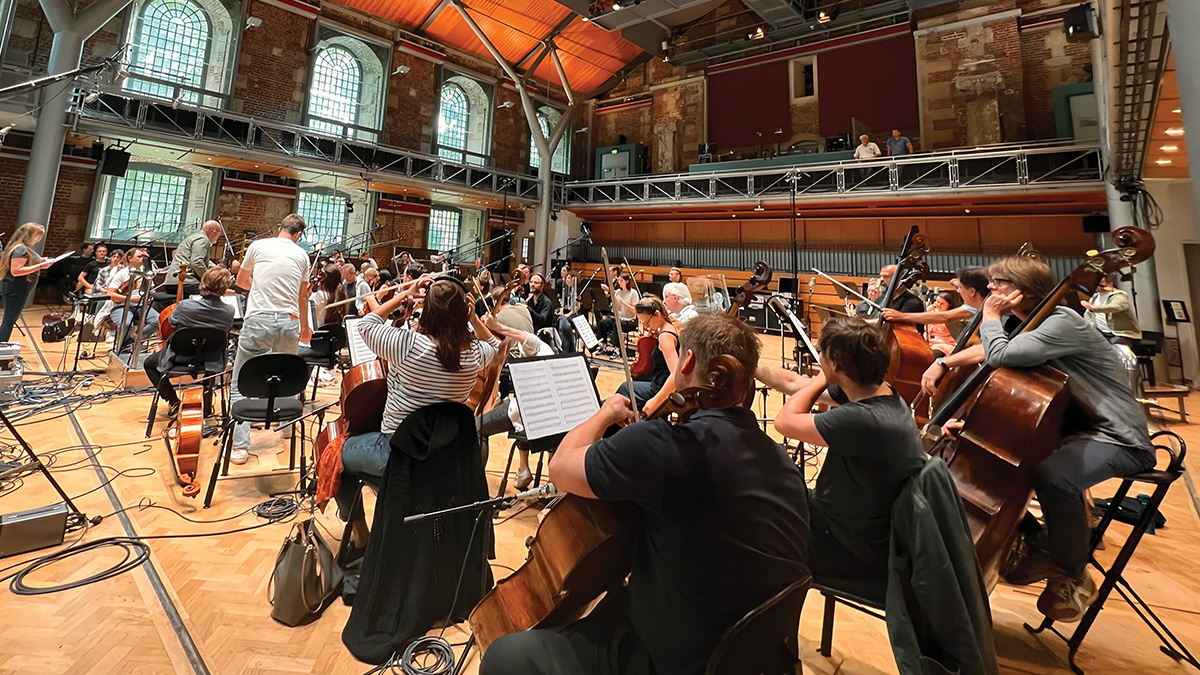How Netflix’s Life on Our Planet Created the Music of Evolution
Composer Lorne Balfe delves into the process of scoring life itself in Netflix's Life on Our Planet.

This article is presented by 
Life on Our Planet is an ambitious undertaking, breaking down the history of the world through stories of survival, extinction, catastrophe, and evolution. The documentation of the earth’s development is more than a mere visual representation of the journey from primordial ooze, however. Evolution has a sound. Its theme is a universal harmonic, but the passing tones are dissonant.
Life on the place we call home relentlessly grew over its four-billion-year history, and the series required a composer whose mission is sonic exploration: Step forward Scottish composer Lorne Balfe, who scored box office blockbusters including Top Gun: Maverick—on which he worked with Lady Gaga—and several Mission: Impossible films. The musical veteran found new ground with Life on Our Planet. “I’ve never done anything in this genre,” Balfe tells us. “I always tried different things. If I do an action movie, I have a break and go to Disney, like Ticket to Paradise with George Clooney and Julia Roberts.”
Life on Our Planet is not set in paradise, although some landscapes fleetingly pass for Eden on the surface. It begins in a pristine but lethal environment.
Out of noxious gas and raging waters, a single cell develops, known as LUCA, the Last Universal Common Ancestor. This ancient bacteria is the greatest single character in the history of the planet. Its reach is epic, and the conclusion is as dramatic as all stories ever told. It makes for an intriguing project.
“You choose something because it interests you, whets the appetite,” Balfe says. “What I liked was doing things in the past and present. That was very unique to me. Also, getting to help tell a story to something that has the voice of God.”
He is speaking of the narrator, the all-knowing Morgan Freeman. Life on Our Planet presents Earth as a cruel and unforgiving place, but Balfe found the creative team welcoming. “I’m the newbie,” Balfe says. “The audience is expecting a certain thing. The creatives from [production company] Silverback have a vast knowledge of storytelling in this genre. As soon as we started talking, I started seeing it.”
Balfe is working in the tradition of pieces like “Rite of Spring,” “The Blue Danube,” or “Here Comes the Sun.” The soundtrack has to capture nature thematically and strives to be timeless. “It’s about understanding the next generation that’s going to be watching this and learning from it,” Balfe says. “If there’s a theme you automatically can grab onto, that will always help the storytelling.”
Sound and vision have always been interconnected in Balfe’s artistic process. “I never wrote music that wasn’t to-picture,” he says. “I always needed some bigger force to instruct while creating.” The directors of Life on Our Planet suggested the universal source material.
“It’s strange,” Balfe says. “There wasn’t any direction of composition, no discussing music in great detail. We discussed the emotion and how the audience is going to relate to it.”
The Netflix series asks viewers to expand their worldview, and the music helps bridge fantastical realities to familiar territory.
The audience may have never heard of the long-extinct Terrorbird or understand how the Lystrosaurus held a key to surviving the Permian Extinction, but their stories are compelling, regardless of their theoretical design and imagined onscreen rendering. Balfe’s accompaniment breathes life into the filmmakers’ vision.
“When you are seeing something that might not necessarily exist, you can still have empathy for it and understand the journey, because this show is really about the journey,” Balfe says.
Even some musical instruments were chosen for their physical presence and how they represent the basics of adaptability and survival. “I wanted to have the concept of life and breath,” Balfe says. “That’s why we ended up recording Anna Lapworth, who’s an amazing organist, at the Royal Albert Hall. It’s a very classical instrument that’s got life to it. The air that’s pumped through it… I tried to create a school that ‘what you hear is what you see.’”
Like most screen projects, some of the soundtrack was composed for filmed footage, and other sequences allow the music to propel the experience. “There was a clear bible of musical themes,” Balfe says. Holding it all together are the central themes of survival, predators, prey, and sustenance.
“We started this by creating the food groups,” Balfe says. “You’ve got to have a clear building block. You know what the story is. You’ll be going into the world of mammals; you know you’re covering world extinction.”
The composer had to create distinct and recognizable leitmotifs for a multitude of creatures, events, and the character of evolution. He also had to organize the primitive chaos of sound into a narrative structure that would propel a story through eight episodes.
“It was important to create suites and themes that will cover the whole series,” Balfe says. “What is our connection to the concept of extinction and the fact that it does happen, has happened, and will happen? It’s about mortality. So it’s getting into an emotional state to understand how to write about it.”
One might think a musician writing accompaniment to the whole of nature might do physical exploration to get in the mood. But Balfe took no long walks in the forest or trips to locations barely known to man. “I live in a basement,” he explains. “I’m like Vegas. I don’t have clocks or daylight. There’s a reason most composers have bad complexions.”
To prepare for Life on Our Planet, the first thing the musician did was get to the roots.
“I did research about the oldest instruments,” Balfe says. “I was looking at the bone flutes found in the caves. Knowing that’s your past and mixing that with an electronic school of production, so it’s then-and-now, sometimes you don’t know what you’re hearing or seeing. That was the sonic experiment.”
The sonic experiments may be difficult to achieve properly, but they come across as simple because they are fun. Balfe says: “Opening title sequences are the hardest because you’ve got a minute and a half to sell a story about what the next eight hours is going to be. Nine times out of 10, it will be a song.”
The composer learned brevity early in his career. “I did jingles for a long time. It was a harder job because you have 30 seconds to sell a product. I’ve never seen any difference between jingles and film scoring.”
Although Balfe began as a percussionist, with piano as his primary instrument, his musical vocabulary evolved during creation. “When you’re composing, you have to think in the style of the instrument. There are a lot of vocals because I always wanted to remind the audience this is where we end up as human beings.”
Balfe needed modern Homo sapiens to identify with their place in the ongoing story of Life on Our Planet. “I wanted a connection, and the voice is very important. Before any instrument, the voice was the first thing we were able to create music with.”
To properly capture the soundscape for Mission: Impossible – Dead Reckoning Part One, Balfe recorded more than 500 musicians across the globe. The score for Life on Our Planet is written for a mere 65-piece orchestra. Balfe says dynamics have nothing to do with how many players are in the band.
“Numbers don’t count; it’s the intention,” Balfe says. “With Mission: Impossible, it was the locations. I wanted to connect the musicians to the actual geographical point of view. With this show, there was a concept of singular musicians who brought very unique instrumentation.”
The players needed more than musical chops at auditions; they had to fit their parts. “I treat the musicians the same as a casting agent,” Balfe says. “You choose who you feel connected to. It was very fortunate that I got to work with the London Symphony Orchestra, and also the Royal Scottish National Orchestra. Two of the top orchestras in the world contributed to this series. And it was very special, being able to have all the directors come to the recording sessions.”
Over the course of the series, attuned viewers will notice that even the most chilling of themes accompanying perilous battles of predator and prey end on hopeful notes. This is because every death is a stepping stone to a more advanced way of surviving. Balfe has the same attitude toward his adaptations.
“The only reason that you stop experimenting is time,” Balfe says. “When that clock stops, then you’ve run out of time. But it’s really about evolving. You think differently when you’re working with great musicians; you experiment, they bring something to the table. They improvise, so it’s constantly evolving.”
Stevie Wonder wrote an album called Songs in the Key of Life, which begs the question of whether Life on Our Planet has a key. “There is a technical thing about sample rate,” Balfe says and grins. “Most of my music is in the key of C. There can’t be a rule because instruments can’t play certain ranges, so the key doesn’t matter. You just have to keep evolving and changing it. The perfect key is harmony.”
Life on Our Planet is streaming now on Netflix.
